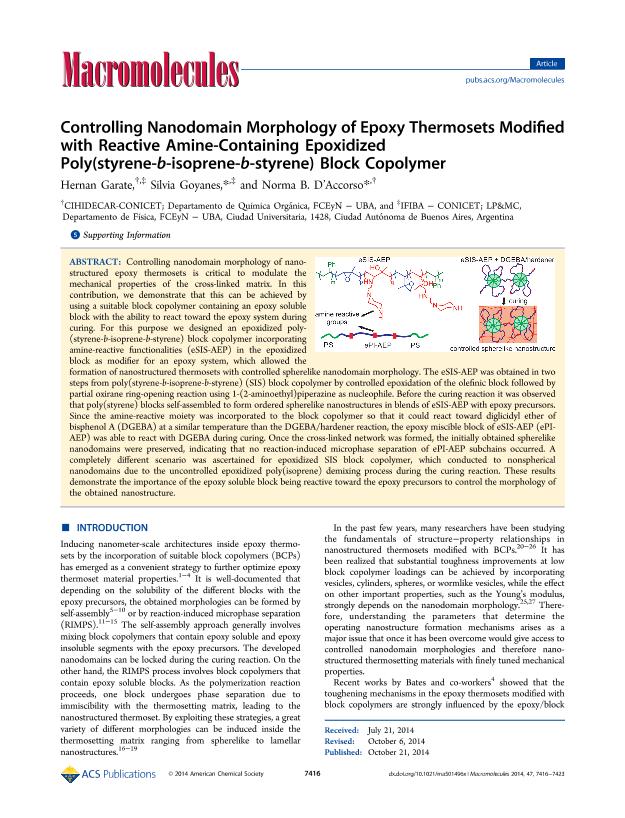Mostrar el registro sencillo del ítem
dc.contributor.author
Garate, Hernán

dc.contributor.author
Goyanes, Silvia Nair

dc.contributor.author
D'accorso, Norma Beatriz

dc.date.available
2018-01-19T21:47:01Z
dc.date.issued
2014-10
dc.identifier.citation
Garate, Hernán; Goyanes, Silvia Nair; D'accorso, Norma Beatriz; Controlling Nanodomain Morphology of Epoxy Thermosets Modified with Reactive Amine-Containing Epoxidized Poly(styrene-b-isoprene-b-styrene) Block Copolymer; American Chemical Society; Macromolecules; 47; 21; 10-2014; 7416-7423
dc.identifier.issn
0024-9297
dc.identifier.uri
http://hdl.handle.net/11336/34052
dc.description.abstract
Controlling nanodomain morphology of nanostructured epoxy thermosets is critical to modulate the mechanical properties of the cross-linked matrix. In this contribution, we demonstrate that this can be achieved by using a suitable block copolymer containing an epoxy soluble block with the ability to react toward the epoxy system during curing. For this purpose we designed an epoxidized poly(styrene-b-isoprene-b-styrene) block copolymer incorporating amine-reactive functionalities (eSIS-AEP) in the epoxidized block as modifier for an epoxy system, which allowed the formation of nanostructured thermosets with controlled spherelike nanodomain morphology. The eSIS-AEP was obtained in two steps from poly(styrene-b-isoprene-b-styrene) (SIS) block copolymer by controlled epoxidation of the olefinic block followed by partial oxirane ring-opening reaction using 1-(2-aminoethyl)piperazine as nucleophile. Before the curing reaction it was observed that poly(styrene) blocks self-assembled to form ordered spherelike nanostructures in blends of eSIS-AEP with epoxy precursors. Since the amine-reactive moiety was incorporated to the block copolymer so that it could react toward diglicidyl ether of bisphenol A (DGEBA) at a similar temperature than the DGEBA/hardener reaction, the epoxy miscible block of eSIS-AEP (ePI-AEP) was able to react with DGEBA during curing. Once the cross-linked network was formed, the initially obtained spherelike nanodomains were preserved, indicating that no reaction-induced microphase separation of ePI-AEP subchains occurred. A completely different scenario was ascertained for epoxidized SIS block copolymer, which conducted to nonspherical nanodomains due to the uncontrolled epoxidized poly(isoprene) demixing process during the curing reaction. These results demonstrate the importance of the epoxy soluble block being reactive toward the epoxy precursors to control the morphology of the obtained nanostructure.
dc.format
application/pdf
dc.language.iso
eng
dc.publisher
American Chemical Society

dc.rights
info:eu-repo/semantics/openAccess
dc.rights.uri
https://creativecommons.org/licenses/by-nc-sa/2.5/ar/
dc.subject
Controlling Nanodomain
dc.subject
Reactive Block Copolymers
dc.subject
Epoxy Thermosets
dc.subject.classification
Otras Ciencias Químicas

dc.subject.classification
Ciencias Químicas

dc.subject.classification
CIENCIAS NATURALES Y EXACTAS

dc.title
Controlling Nanodomain Morphology of Epoxy Thermosets Modified with Reactive Amine-Containing Epoxidized Poly(styrene-b-isoprene-b-styrene) Block Copolymer
dc.type
info:eu-repo/semantics/article
dc.type
info:ar-repo/semantics/artículo
dc.type
info:eu-repo/semantics/publishedVersion
dc.date.updated
2018-01-12T19:49:27Z
dc.journal.volume
47
dc.journal.number
21
dc.journal.pagination
7416-7423
dc.journal.pais
Estados Unidos

dc.description.fil
Fil: Garate, Hernán. Consejo Nacional de Investigaciones Científicas y Técnicas. Oficina de Coordinación Administrativa Ciudad Universitaria. Centro de Investigaciones en Hidratos de Carbono. Universidad de Buenos Aires. Facultad de Ciencias Exactas y Naturales. Centro de Investigaciones en Hidratos de Carbono; Argentina
dc.description.fil
Fil: Goyanes, Silvia Nair. Consejo Nacional de Investigaciones Científicas y Técnicas. Oficina de Coordinación Administrativa Ciudad Universitaria. Instituto de Física de Buenos Aires. Universidad de Buenos Aires. Facultad de Ciencias Exactas y Naturales. Instituto de Física de Buenos Aires; Argentina
dc.description.fil
Fil: D'accorso, Norma Beatriz. Consejo Nacional de Investigaciones Científicas y Técnicas. Oficina de Coordinación Administrativa Ciudad Universitaria. Centro de Investigaciones en Hidratos de Carbono. Universidad de Buenos Aires. Facultad de Ciencias Exactas y Naturales. Centro de Investigaciones en Hidratos de Carbono; Argentina
dc.journal.title
Macromolecules

dc.relation.alternativeid
info:eu-repo/semantics/altIdentifier/doi/http://dx.doi.org/10.1021/ma501496x
dc.relation.alternativeid
info:eu-repo/semantics/altIdentifier/url/http://pubs.acs.org/doi/10.1021/ma501496x
Archivos asociados
